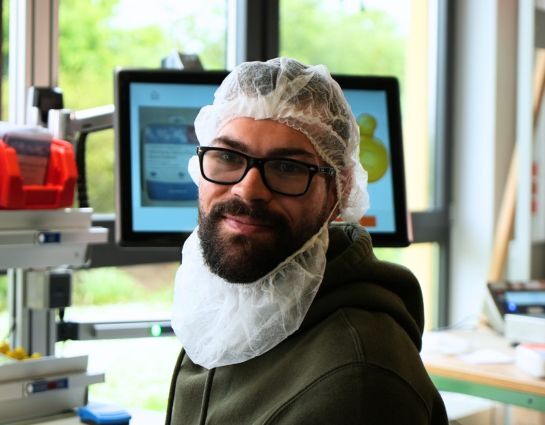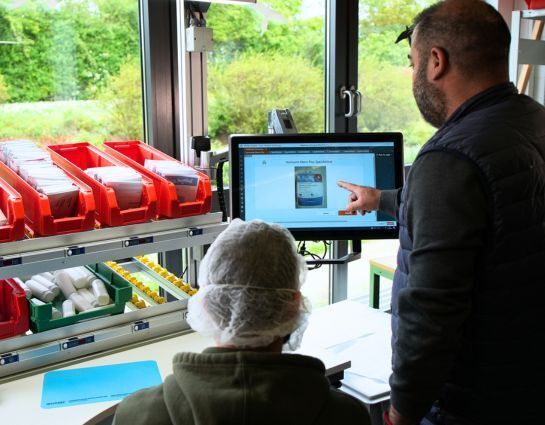- Products
- Solutions
- Service
- Company
MiniTec SmartAssist is increasingly being implemented in workshops for people with disabilities. These environments clearly demonstrate how the assistance system not only supports training and improves quality, but also opens up new opportunities for inclusive employment.
Workshops for people with disabilities (WfbM) are an ideal application area for MiniTec SmartAssist. The system’s ability to adapt to the individual needs of employees with various disabilities proves especially beneficial. A key advantage is that supervisors can use the integrated editor to create customized instructions and tools tailored to the specific capabilities of their team.
One of the early adopters of the system in this sector is the Nieder-Ramstädter Diakonie (NRD) foundation. For over 125 years, the NRD has been committed to supporting people with disabilities, as well as children, adolescents, families, and the elderly. Their services span various areas of social work and inclusion—including housing & care, education & development, employment & activities, counseling & support, and other related services. With over 2,700 employees across more than 40 locations in Hesse and Rhineland-Palatinate, the NRD is a key regional player. At the Rheinhessen Workshop (RHW) in Wörrstadt, around 150 employees with diverse cognitive and physical impairments are currently employed.

Focused at work – supported by images, text, and light signals. Due to hygiene requirements for the test kits, employees wear hair coverings.

Task completed – MiniTec SmartAssist gives a thumbs-up: Positive confirmation matters.
Greater Efficiency and Inclusion as Core Objectives
At the RHW, workers assemble test kits for medical laboratories—each kit consisting of various components packed into a resealable plastic bag. Given the approximately 300 different set variations, ensuring the correct contents in each bag is a challenging task. This is where the MiniTec SmartAssist system delivers real value.
From the beginning, project manager Stefani Hirschenkrämer had a clear vision for the use of SmartAssist: “Our goal was twofold: to reduce training time and to empower our employees—especially those already working on simpler production tasks—to handle more complex processes independently. The digital workstation had to meet several specific criteria: it needed to be customizable to individual capabilities, support all kit assembly variations, and be easy to use. MiniTec SmartAssist met all of these requirements perfectly.”
Ergonomics also played a key role. The height-adjustable MiniTec workstation helps prevent strain and posture-related issues, allowing employees to work comfortably while sitting or standing. It includes a cut-out and adjustable clearance for wheelchair users. The positioning of tools, measuring devices, and components is also adapted to each employee’s physical range of motion.
SmartAssist Workstation Setup and Workflow
The workstation features ten material boxes—two larger ones placed to the left and right, and eight smaller ones positioned in front of the employee, equipped with pick-to-light LED strips. A touchscreen and push buttons provide interaction with the assistance system. The monitor displays each step of the task, prompts for material selection, intermediate checkpoints, and the final target state. Using visual step-by-step instructions via lights and the screen, the system indicates exactly which material to select and from which container—highlighted by a green LED. A light barrier verifies the correct selection. The monitor then allows a visual comparison to ensure the correct item has been chosen. Once the task is completed successfully, the employee is rewarded with a cheerful “thumbs-up” smiley as positive feedback.
Creating Instructions with the Editor
A central component of the MiniTec assistance system is the intuitive SmartEdi editor, which allows the RHW team to create and manage assembly instructions easily. For Stefani Hirschenkrämer, this is a major benefit:
“Using the editor is really simple—like working with PowerPoint. Uploading images and videos is quick, and configuring the pick-to-light system is straightforward. It’s so user-friendly that even our employees can operate it themselves. We’ve developed a standardized layout template that clearly defines where images go and what icons (arrows, etc.) are available. The system is also very flexible—if we need to add a step, we can do it directly at the workstation.” She sees clear advantages of MiniTec SmartAssist over competing systems, particularly when it comes to ease of use and adaptability.

Adjustments to the instructions can be easily made using the editor.

Stefani Hirschenkrämer is convinced of the benefits of MiniTec SmartAssist.
Faster Onboarding, More Independence
For Stefani Hirschenkrämer, the benefits of SmartAssist are clear: “The system opens up new employment opportunities for our workers. Combined with adapted workstations, it enables them to perform tasks independently—even after only a brief training period. MiniTec SmartAssist allows for faster learning and boosts our employees' self-confidence. They can now complete an entire set on their own instead of, for example, just tightening a single tube. And importantly, it also relieves our specialist staff, who no longer need to supervise the entire onboarding process.”